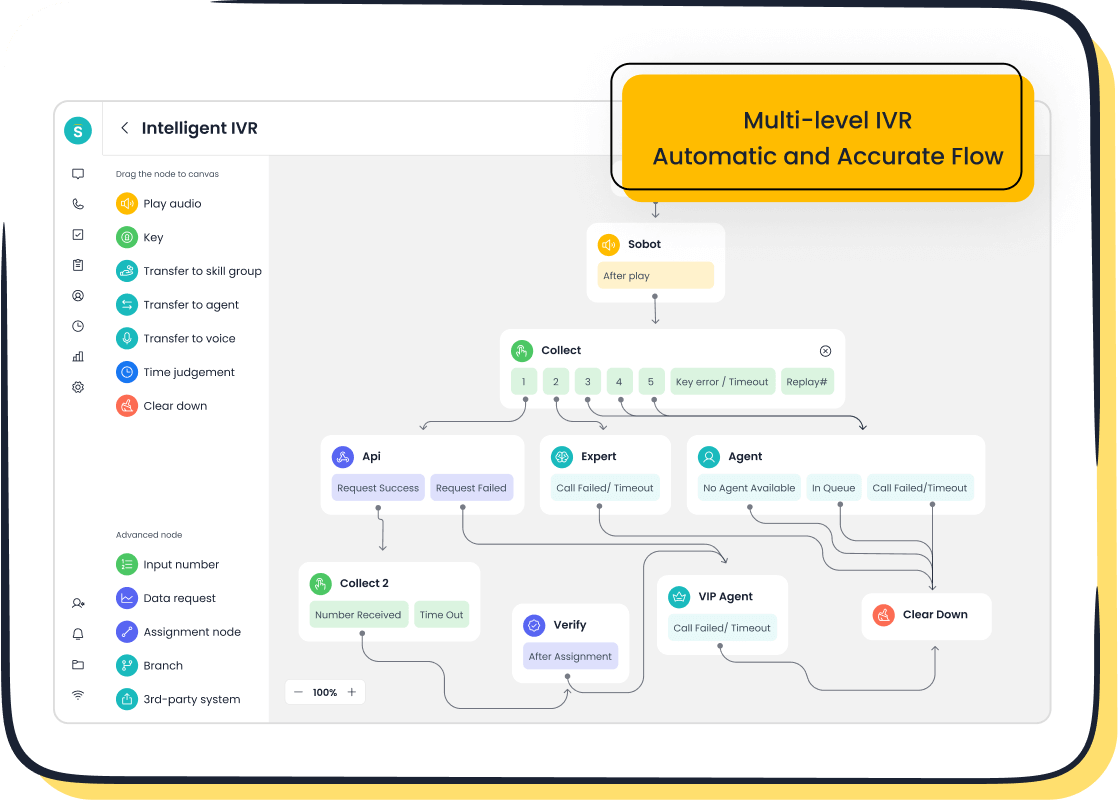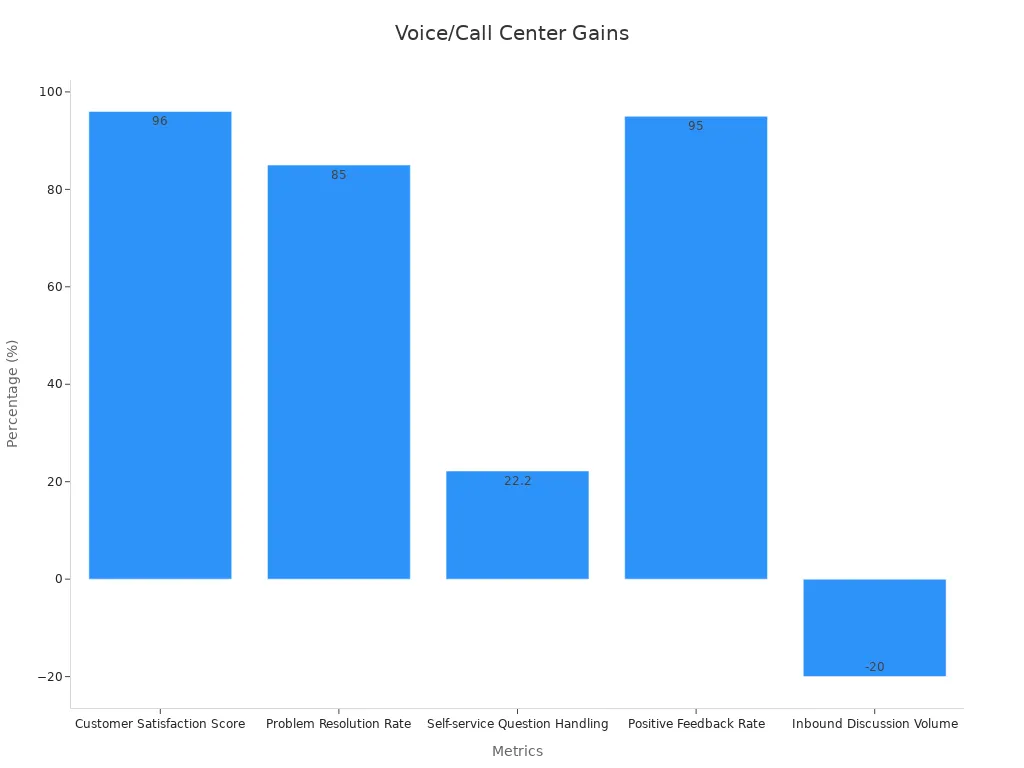How Tone and Language Impact Customer Perception and Trust

How you speak to your customers matters more than you might think. The tone you use sets the emotional stage for the interaction, while your choice of language ensures clarity and understanding. Did you know that 96% of customers say excellent customer service builds trust? Or that 94% are likely to buy again after a positive experience? This shows just how powerful communication can be in shaping loyalty. Tools like Sobot’s Voice/Call Center help businesses master how to talk in customer service, ensuring every interaction feels personal, empathetic, and effective.
Understanding Tone and Language in Customer Service
What Is Customer Service Tone and Why Does It Matter?
Your tone of voice in customer service sets the stage for how customers perceive your brand. It’s not just about what you say but how you say it. A warm, empathetic tone can make customers feel valued, while a cold or dismissive tone can push them away. Research shows that tone impacts 38% of customer interactions. Even the most positive words lose their effect if the tone doesn’t show empathy.

Think about this: customers are more likely to stay loyal to brands that demonstrate understanding and care through their tone of voice. Whether you’re handling a complaint or answering a simple question, your approach matters. Tools like Sobot’s Voice/Call Center help ensure your team consistently delivers the right tone, fostering trust and engagement.
The Role of Language in Shaping Customer Interactions
Language is the backbone of customer communication. Clear, concise language prevents misunderstandings and builds confidence. When you use simple, direct words, customers feel heard and understood. But language isn’t just about clarity—it’s also about connection.
For example, using inclusive language can make customers feel like they belong. Multilingual support, like the one offered by Sobot’s Voice/Call Center, ensures you can communicate effectively with diverse audiences. This feature helped Weee!, an online Asian supermarket, overcome language barriers and achieve a 96% customer satisfaction score.
Emotional Intelligence and Its Connection to Tone and Language
Emotional intelligence (EI) is your secret weapon for mastering tone and language. It helps you recognize and manage emotions—both yours and your customers’. Agents with strong EI can connect emotionally, making interactions more meaningful.
Here’s why this matters: 87% of customers say tone of voice is the most critical part of communication. They remember how they felt during the interaction more than the actual words. By showing empathy and responding thoughtfully, you create positive emotional communication. Sobot’s AI-powered Voicebot enhances this by recognizing customer intent and delivering personalized responses, ensuring every experience feels tailored.
How Tone and Language Influence Customer Perception

The Psychology of First Impressions in Customer Service
First impressions matter, especially in customer service. When customers reach out, they form an opinion about your brand within seconds. This impression often depends on the tone and language you use. A friendly greeting like, “Hi! How can I help you today?” immediately sets a positive tone. On the other hand, a robotic or rushed response can make customers feel unimportant.

Psychologists suggest that humans are wired to make snap judgments. In customer service, this means your tone can either build trust or create doubt. For example, a warm and empathetic tone reassures customers that their concerns matter. Sobot’s Voice/Call Center helps businesses nail this first impression by offering features like intelligent IVR and AI-powered Voicebots. These tools ensure every interaction starts on the right note, no matter the customer’s mood or issue.
Positive vs. Negative Tone: Examples and Impacts
Your tone can either strengthen or weaken customer relationships. A positive tone makes customers feel valued, while a negative one can drive them away. Let’s look at some examples:
-
Positive Tone:
Customer: “I didn’t receive my order.”
Agent: “I’m so sorry to hear that! Let me check on this for you right away.” -
Negative Tone:
Customer: “I didn’t receive my order.”
Agent: “That’s not our fault. Did you check your email?”

In the first example, the agent shows empathy and takes responsibility, which builds trust. In the second, the dismissive tone frustrates the customer. Research shows that emotional appeals, like using kind and relatable language, can enhance customer relations. Sobot’s tools, like call tracking and real-time monitoring, help teams maintain a positive tone by providing insights into customer interactions.
Empathy and Clarity: Building Confidence in Customer Interactions
Empathy and clarity are the cornerstones of effective communication. When you show empathy, you acknowledge the customer’s feelings, making them feel understood. For instance, saying, “I understand how frustrating this must be,” can instantly calm an upset customer. Clarity, on the other hand, ensures your message is easy to understand.
Imagine a customer asking about a refund policy. A clear response like, “You’ll receive your refund within 5 business days,” leaves no room for confusion. Combining empathy with clarity builds confidence in your service. Sobot’s multilingual support and AI-driven Voicebots excel at delivering clear and empathetic responses, even in complex situations. This approach helped Weee! overcome language barriers and achieve a 96% customer satisfaction score.
Tip: Always listen actively and respond thoughtfully. Customers remember how you made them feel more than what you said.
The Role of Tone and Language in Building Customer Trust

Why Trust Is the Cornerstone of Customer Relationships
Trust is the glue that holds customer relationships together. Without it, even the best products or services can fall short. When customers trust your brand, they’re more likely to return, recommend you to others, and forgive occasional mistakes. But how do you build this trust? It starts with how you communicate.
Your tone and language play a huge role in shaping trust. A warm, empathetic tone shows customers you care about their concerns. Clear and direct language ensures they understand your message without confusion. Neurological studies reveal that we process tone and words in separate parts of the brain. This means your tone can completely change how customers interpret your words.
Did you know? Customers who feel valued during interactions are 60% more likely to stay loyal to your brand. By showing empathy and maintaining a consistent customer service tone, you create a foundation of trust that strengthens every interaction.
How Miscommunication Can Undermine Trust
Miscommunication is one of the fastest ways to lose customer trust. Imagine asking a question and receiving a vague or unclear response. Frustrating, right? Miscommunication often stems from poor tone or unclear language, leaving customers feeling unheard or confused.
For example, if a customer asks about a delayed delivery and the agent responds with, “It’s not our fault,” the dismissive tone damages trust. On the other hand, saying, “I understand how frustrating this must be. Let me check on this for you,” shows empathy and builds confidence.

Miscommunication doesn’t just affect customer service—it affects customer experience as a whole. Tools like Sobot’s Voice/Call Center help prevent these issues. Features like call tracking and real-time monitoring ensure agents stay on track, delivering clear and empathetic responses. Multilingual support also eliminates language barriers, ensuring every customer feels understood.
Sobot’s Voice/Call Center: Enhancing Trust Through Effective Communication
Sobot’s Voice/Call Center is designed to help you build trust through high-quality customer service. Its intelligent IVR system ensures customers are routed to the right agent, reducing frustration and wait times. The AI-powered Voicebot recognizes customer intent, delivering personalized responses that show empathy and understanding.
The platform’s unified workspace lets agents access customer information in one place, making communication seamless and efficient. Real-time monitoring and analytics provide insights into customer interactions, helping teams refine their approach and maintain a positive tone.
Take Weee!, for example. By implementing Sobot’s Voice/Call Center, they overcame language barriers and improved customer satisfaction to an impressive 96%. The flexible IVR system and multilingual support allowed them to deliver excellent customer service, even across different time zones.
Pro Tip: Use tools like Sobot’s Voice/Call Center to ensure every interaction feels personal and trustworthy. When customers know you’re listening and responding thoughtfully, they’ll keep coming back.
Actionable Tips for Mastering Tone and Language
How to Talk in Customer Service: Adapting to Emotional States
Every customer interaction is unique, and emotions play a big role in shaping the experience. When customers feel frustrated or upset, your ability to adapt your tone can turn things around. Emotional intelligence is key here. It helps you recognize how customers feel and adjust your approach accordingly.
Imagine this: A customer calls feeling unheard after a delayed delivery. If you respond with empathy—“I understand how frustrating this must be. Let me fix this for you”—you instantly create a positive connection. On the other hand, a dismissive tone can escalate the situation.
Customer service training programs that include role-playing scenarios are a great way to practice adapting to emotional states. They teach you how to use empathy and appropriate responses to handle tough situations. Tools like Sobot’s Voice/Call Center can help by offering real-time monitoring and AI-powered Voicebots that recognize customer intent and emotions, ensuring every interaction feels personal and thoughtful.
Tip: Always listen actively and acknowledge emotions before offering solutions. Customers remember how you made them feel more than what you said.
Maintaining Professionalism Across Communication Channels
Professionalism is the backbone of excellent customer service. Whether you’re on a call, writing an email, or chatting on social media, your tone and language should reflect your brand’s values. Consistency matters. Customers expect the same level of professionalism across all channels.
Here’s how you can ensure this:
- Define Universal Standards: Establish core values like empathy, clarity, and solution-oriented communication.
- Tailor Your Approach: Adjust your tone for each channel. For example, calls require warmth and empathy, while emails demand clear and concise language.
- Leverage Feedback: Use customer feedback to refine your communication style and meet expectations.
| Quality Assurance Element | Description |
|---|---|
| Universal Quality Standards | Define professionalism, empathy, and solution-oriented approaches. |
| Channel-Specific Evaluations | Tailor tone and grammar to fit the unique requirements of each channel. |
| Customer Feedback Integration | Incorporate customer preferences to ensure high-quality service. |

Sobot’s Omnichannel Solution simplifies this process by unifying communication across platforms. Its analytics tools help you monitor tone consistency and improve customer engagement.
Using Positive Language to De-escalate Challenging Situations
Positive language is your secret weapon for handling tough customer interactions. It not only calms frustrated customers but also builds trust and loyalty. For example, instead of saying, “I can’t do that,” try, “Here’s what I can do to help.” This shift in tone makes customers feel valued and understood.
Studies show that 54% of customers stop purchasing from a brand after a single bad experience. Positive scripting can prevent this. It improves service quality and reduces escalated issues. Tools like Sobot’s Voice/Call Center provide call tracking and real-time monitoring, helping agents stay focused on delivering positive responses.
Pro Tip: Use phrases like “I understand” and “Let’s solve this together” to show empathy and maintain a positive approach. Customers appreciate solutions that feel collaborative and supportive.
Training Teams to Develop a Consistent Customer Service Tone
Consistency in tone is the backbone of excellent customer service. When your team speaks with one voice, customers feel confident and valued. But how do you ensure this consistency? It starts with comprehensive customer service training and coaching.
Training equips your team with the skills to deliver appropriate responses, no matter the situation. For example, role-playing exercises can help agents practice handling frustrated customers with a positive approach. Regular coaching sessions reinforce these skills, ensuring your team stays sharp and aligned with your brand’s values.
Tip: Use performance reviews to identify strengths and areas for improvement. Feedback from these reviews helps agents refine their communication style and maintain consistency.
Comprehensive training doesn’t just benefit your customers—it also boosts your team’s performance. Here’s how:
| Benefit | Description |
|---|---|
| Improved Employee Engagement | Employees who receive comprehensive training are more engaged, leading to better communication. |
| Increased Productivity | Training enhances productivity, which contributes to more consistent communication outcomes. |
| Higher Customer Satisfaction | Satisfied customers are a result of effective communication, which is fostered by training. |
Sobot’s Voice/Call Center can play a key role in this process. Its real-time monitoring and analytics tools allow you to track how well your team applies customer service tone tips during interactions. These insights make it easier to tailor coaching sessions and improve overall performance.
Imagine this: A customer calls with a complaint about a delayed order. Thanks to training, your agent responds with empathy and clarity, saying, “I understand how frustrating this must be. Let me fix this for you.” This positive approach not only resolves the issue but also builds trust.
By investing in customer service training, you empower your team to deliver consistent, high-quality service. Customers notice when your team communicates with professionalism and care, and they’ll keep coming back because of it.
Adapting Tone and Language Across Platforms
Best Practices for Phone Support Using Sobot’s Voice/Call Center
Phone support is often the first touchpoint for customers, making it crucial to get your tone of voice right. A friendly and empathetic tone can instantly put customers at ease, while clear communication ensures their concerns are addressed effectively. Sobot’s Voice/Call Center offers tools like intelligent IVR and AI-powered Voicebots to help you achieve this. These features ensure calls are routed to the right agents and that responses are personalized and empathetic.
The results speak for themselves. Businesses using Sobot’s Voice/Call Center have seen a 96%+ customer satisfaction score and an 85% problem resolution rate. The platform also reduces inbound discussion volume by 20%, allowing your team to focus on delivering quality service.

Tip: Always greet customers warmly and listen actively. Tools like Sobot’s real-time monitoring can help you refine your approach and maintain a positive tone throughout the call.
Writing Emails and Chat Messages with a Consistent Tone of Voice
Consistency in tone of voice is key when communicating through emails and chat. Customers expect the same level of professionalism and empathy they’d receive over the phone. To achieve this, define clear brand voice guidelines. These should include personality traits, dos and don’ts, and examples of how to handle different scenarios.
For instance, Airbnb increased conversion rates by 10% by maintaining a consistent tone in its emails and chat messages. You can achieve similar results by using tools like Sobot’s unified workspace, which consolidates customer data and ensures seamless communication. This approach not only saves time but also helps you deliver personalized responses that align with your brand’s values.
| Best Practice | Description |
|---|---|
| Develop brand voice guidelines | Clearly define your brand's voice and tone, ensuring alignment with values. |
| Outline personality traits | Identify traits like friendly or authoritative to guide tone across contexts. |
| Document dos and don’ts | Provide clear instructions for language, style, and tone across platforms. |
| Use specific examples | Include scenarios like emails or social posts to illustrate tone application. |
| Maintain flexibility | Ensure guidelines can adapt to different audiences while keeping core values. |
Pro Tip: Use positive language in emails and chat to de-escalate issues. For example, replace “I can’t do that” with “Here’s what I can do to help.”
Social Media Communication: Aligning Tone with Brand Identity
Social media is where your brand’s personality shines. Customers expect engaging, relatable, and on-brand communication. Aligning your tone with your brand identity is essential for building trust and fostering engagement. Studies show that interaction and trendiness significantly boost customer engagement on social platforms.
| Dimension | Impact on Engagement Performance | Source |
|---|---|---|
| Entertainment | Crucial for engaging customers | Liu et al. (2021) |
| Interaction | Bridges gap between customers and brands | Straker and Wrigley (2016) |
| Trendiness | Keeps customers updated with products | Liu et al. (2021) |
Sobot’s Omnichannel Solution simplifies social media management by unifying communication across platforms. Its analytics tools help you monitor tone consistency and ensure your posts resonate with your audience. Whether you’re responding to a comment or sharing an update, staying true to your brand’s voice builds stronger connections with customers.
Tip: Use humor or storytelling to make your posts more engaging. Just ensure it aligns with your brand’s personality and values.
Mastering tone and language in customer service isn’t just about communication—it’s about connection. When you use a warm tone, personalize interactions, and express gratitude, customers feel valued and understood. These elements build trust, strengthen relationships, and enhance satisfaction.
| Evidence Type | Description |
|---|---|
| Warm and Friendly Tone | Improves service tone, leading to happier customers and better satisfaction rates. |
| Personalization | Creates rapport and makes customers feel valued, boosting overall satisfaction. |
| Clarity of Intent | Establishes trust and sets expectations, ensuring customers feel understood. |
| Expressing Gratitude | Reinforces a positive tone, fostering trust and encouraging open communication. |
Sobot’s Voice/Call Center empowers businesses to deliver consistent communication across platforms. Its intelligent IVR and AI-powered Voicebot ensure every interaction feels personal and thoughtful. By mastering tone and language, you can create experiences that keep customers coming back.
Tip: Always prioritize empathy and clarity in your communication. Customers remember how you made them feel more than what you said.
FAQ
What is the best way to improve tone in customer service?
Focus on empathy and active listening. Use positive language to show you care about the customer’s concerns. For example, instead of saying, “I can’t help,” say, “Here’s what I can do.” Tools like Sobot’s Voice/Call Center can help maintain a consistent tone.
How can I ensure clear communication with customers?
Keep your language simple and direct. Avoid jargon or overly technical terms. If you’re explaining a process, break it into steps. Sobot’s multilingual support ensures clarity across languages, helping you connect with diverse audiences effectively.
Why is emotional intelligence important in customer service?
Emotional intelligence helps you understand and respond to customer emotions. It builds trust and creates meaningful interactions. For instance, recognizing frustration and responding with empathy can turn a negative experience into a positive one. Sobot’s AI-powered Voicebot enhances this by identifying customer intent and emotions.
How does Sobot’s Voice/Call Center improve customer interactions?
Sobot’s Voice/Call Center offers features like intelligent IVR, AI-powered Voicebots, and real-time monitoring. These tools ensure calls are routed correctly, responses are empathetic, and agents have the data they need to resolve issues quickly. Businesses like Weee! have seen a 96% satisfaction rate using these solutions.
What role does tone play in building customer trust?
Tone sets the emotional stage for interactions. A warm, empathetic tone shows customers you value them, while a dismissive tone can harm trust. Studies show that 87% of customers prioritize tone over words. Sobot’s tools help you maintain a positive tone consistently.
See Also
Comparative Analysis of Leading Customer Feedback Software
Best Ten Customer Insight Tools for 2024 Revealed
Comparison of Leading Interactive Voice Response Solutions
Essential Guide to Quality Management Systems in Call Centers
